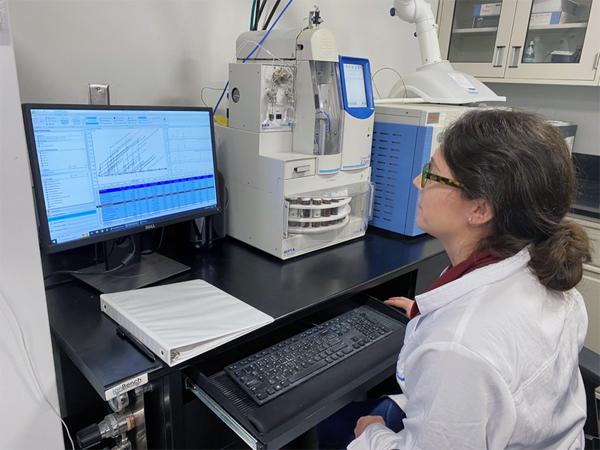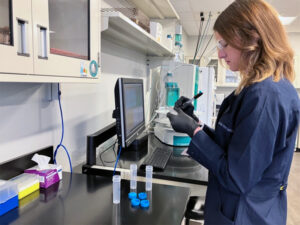 Keeping Louisville Pure Tap® the highest-quality drinking water is our goal.
Keeping Louisville Pure Tap® the highest-quality drinking water is our goal.
Louisville Water’s priority is public health, providing the community with drinking water that excels in quality. And we are prepared to meet new Environmental Protection Agency’s (EPA) proposed regulatory standards for a group of contaminants called PFAS. The standard would not take effect for several years, but we want the community to understand what we’re doing now to protect our water quality.
Addressing a human-made contaminant, PFAS
The EPA has proposed a regulatory goal for six PFAS compounds. These are manufactured chemicals and do not naturally occur. If finalized, the EPA would individually regulate the maximum allowed level of PFOA and PFOS in drinking water and would regulate four other PFAS compounds, including GenX as a mixture with a new Hazard Index.
The scientific terminology can be confusing, but the bottom line is Louisville Water will meet the proposed regulations and protect the quality of your drinking water.
More about the Proposed Standard and Our Data
 The EPA proposes to regulate PFOA and PFOS at 4 parts per trillion (ppt.) For perspective, one part per trillion is equal to one second in 32,000 years. At Louisville Water, our research indicates levels of PFOA and PFOS in drinking water that are below the proposed regulatory standard. Our latest research shows an average of 0 ppt for PFOS and 1.9 – 2.0 ppt for PFOA.
The EPA proposes to regulate PFOA and PFOS at 4 parts per trillion (ppt.) For perspective, one part per trillion is equal to one second in 32,000 years. At Louisville Water, our research indicates levels of PFOA and PFOS in drinking water that are below the proposed regulatory standard. Our latest research shows an average of 0 ppt for PFOS and 1.9 – 2.0 ppt for PFOA.
The other four PFAS compounds include hexafluoropropylene oxide dimer acid (HFPO-DA) or Gen X, Perfluorononanoic acid (PFNA), Perfluorohexanesulphonic acid (PFHxS), and Perfluorobutane sulfonic acid (PFBS). The EPA is using a unitless Hazard Index of 1.0 for this proposed regulation. For these four PFAS compounds our monitoring indicates the calculated Hazard Index is <0.10, well below the Hazard Index regulatory threshold of 1.0 proposed by EPA.
The source of PFAS compounds in the Ohio River comes from manufacturing facilities and products containing PFAS chemicals. While Louisville Water does not contribute to these contaminants occurring in the source of our drinking water, we continue to research treatment options to reduce levels even lower than what we currently detect. One of those options is using activated carbon, something Louisville Water already utilizes.
How am I exposed to PFAS chemicals?
Most of your exposure to PFAS chemicals comes from things other than drinking water. PFAS are manufactured chemicals, and these compounds do not naturally occur. PFAS stands for per- and polyfluoroalkyl substances and the EPA says most of our exposure to PFAS chemicals, more than 80%, comes from consumer goods and not drinking water. In the 1940s, manufacturers began using these compounds to produce industrial and household items like non-stick cookware, waterproof fabric, fast food packaging, pesticides, firefighting foam, and more. The use of PFAS has changed over time and many PFAS compounds are still used in manufacturing today.
 In the mid-2000s, following research that indicated health concerns with two PFAS chemicals, PFOA and PFOS, at low levels, EPA banned their use. However, these chemicals are persistent. Because PFAS contaminants can dissolve in water, scientists detect them in lakes, rivers, and groundwater. In chemical and product manufacturing, GenX compounds replaced PFOA and PFBS replaced PFOS.
In the mid-2000s, following research that indicated health concerns with two PFAS chemicals, PFOA and PFOS, at low levels, EPA banned their use. However, these chemicals are persistent. Because PFAS contaminants can dissolve in water, scientists detect them in lakes, rivers, and groundwater. In chemical and product manufacturing, GenX compounds replaced PFOA and PFBS replaced PFOS.
EPA has proposed the regulations following years of research, which included learning about the potential health impacts of PFAS at certain levels and how water utilities can manage the risk. The goal is to set the regulation at the lowest possible levels to protect public health considering feasibility and affordability.
In 2023, Louisville Water and thousands of other drinking water utilities will monitor for other PFAS compounds as required by EPA’s Unregulated Contaminant Monitoring Rule. Louisville Water also supports actions to minimize these contaminants entering our source water.
Next Steps after a Proposed Regulation
The EPA’s announcement of the proposed regulation is the first step. The EPA is requesting public comment for the next 60 days and expects to finalize the rule by late 2023 or early 2024. Then, public water utilities across the U.S. will have three years to implement any standards to comply with the regulation.
In the meantime, research and innovation never end at Louisville Water. Our scientists continue to work with the EPA to monitor PFAS levels in the Ohio River and our drinking water. At the same time, we continue to research new treatment options. Protecting the public’s health is at the core of our mission. You can see the additional results of our research and the annual water quality at LouisvilleWater.com. We love to talk about our drinking water, and you can always contact us.

